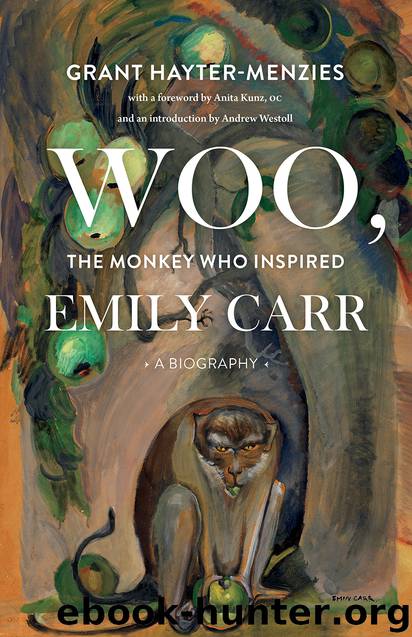Woo, the Monkey Who Inspired Emily Carr by Grant Hayter-Menzies

Author:Grant Hayter-Menzies
Language: eng
Format: epub
Tags: Woo, Monkey, Emily Carr, British Columbia, Biography, Human-animal relationships
ISBN: 9781771622158
Publisher: Douglas and McIntyre (2013) Ltd.
Published: 2019-03-01T16:00:00+00:00
Chapter 7
The Last Summer
Woo’s last camping trip in the Elephant with Carr took place in September 1936. There was no particular reason to assume it would be the last, because at this point the sixty-four-year-old Carr’s life was starting a slow but invigorating upswing. If 1927, the year Carr’s work was exhibited at the National Gallery in Ottawa, leading to wider exposure and her life-changing meeting with Lawren Harris of the Group of Seven, had been a major turning point for Carr as artist, the next five years had brought nationwide recognition not only as artist but as writer and would bring the art world of Canada and numerous admirers from around the world to her modest Victoria doorstep.
Carr was not fond of change, yet she knew she needed it now. She had put Hill House on the market, and by the spring of 1937, she could be happy that she and the animals had survived the sale of and move from Simcoe Street, where Carr had lived since 1913. The property was sold partly in order to pay off debts, but also because it was clear Carr could no longer physically carry out her duties as a landlady. As Dr. Phyllis Marie Jensen wrote, “it was not because of the people contact but the unending tiring responsibility of catering to others when she wanted to be painting and tramping in the woods with her dogs.”160 Giving up her day job would allow Carr the long-desired freedom to pursue her artistic endeavours without distraction.
To prepare for the sale, Carr went about Hill House filling in all the holes in plaster and gouges in wood created by Woo’s active fingers. In what seems a desperate bid to sever herself from her past, she burned countless drawings and paintings, letters and photographs and memorabilia, in the back garden. “I want to cry but I have no tears,” Carr wrote in her journal. By March, her work was done. “I have slipped out of the chemise of worry that 646 Simcoe dressed me in,” she said.161 What she did not realize is that in taking off this old troubling garment, she would don another, newer one, without knowing it at the time or divining how soon it too would begin to weigh on her.
Carr moved to a cottage at 316 Beckley Street, now Beckley Avenue (the cottage’s place taken years ago by a condominium complex) in what was then a working-class district. It was a neighbourhood she came to love and indeed feel more comfortable in than she ever had at 646 Simcoe. “These folk live more,” she wrote.162
Her reputation as artist and eccentric pet lady preceded her, as described by Bert Hudson, who was a boy when Carr moved next door to his parents’ home. It was one thing to see her vivid canvases, hundreds of them, being carted into the cottage, in a neighbourhood where fine art was something that happened somewhere else, and to see her menagerie carried or walked up to the porch.
Download
This site does not store any files on its server. We only index and link to content provided by other sites. Please contact the content providers to delete copyright contents if any and email us, we'll remove relevant links or contents immediately.
Sapiens: A Brief History of Humankind by Yuval Noah Harari(13089)
The Tidewater Tales by John Barth(12040)
Do No Harm Stories of Life, Death and Brain Surgery by Henry Marsh(6346)
Mastermind: How to Think Like Sherlock Holmes by Maria Konnikova(6260)
The Thirst by Nesbo Jo(5803)
Why We Sleep: Unlocking the Power of Sleep and Dreams by Matthew Walker(5668)
Sapiens by Yuval Noah Harari(4561)
Life 3.0: Being Human in the Age of Artificial Intelligence by Tegmark Max(4526)
The Longevity Diet by Valter Longo(4458)
The Rules Do Not Apply by Ariel Levy(3920)
The Immortal Life of Henrietta Lacks by Rebecca Skloot(3838)
The Body: A Guide for Occupants by Bill Bryson(3831)
Why We Sleep by Matthew Walker(3784)
Animal Frequency by Melissa Alvarez(3764)
Yoga Anatomy by Kaminoff Leslie(3718)
Barron's AP Biology by Goldberg M.S. Deborah T(3640)
The Hacking of the American Mind by Robert H. Lustig(3591)
All Creatures Great and Small by James Herriot(3531)
Yoga Anatomy by Leslie Kaminoff & Amy Matthews(3414)
